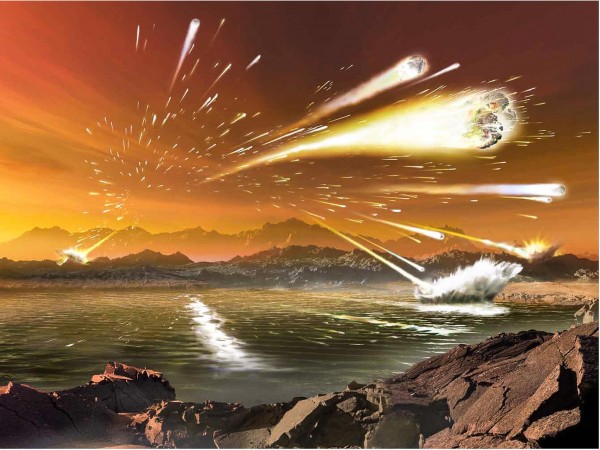A high-powered laser in the Czech Republic has now provided provocative evidence that the hellish conditions produced when an asteroid or comet slams into Earth could have created some key building blocks of life on Earth. In a lab experiment intended to duplicate the high temperatures and pressures of such an impact, researchers used the laser to simultaneously make adenine, guanine, cytosine, and uracil, the four organic compounds in RNA, which many believe to have been the first molecule to encode genetic information.
“This is, I believe, the first time that all four nucleobases have been made in one set of reaction conditions,” says Steven Benner, an astrobiologist at the Foundation for Applied Molecular Evolution in Gainesville, Florida.
Researchers have long sought to identify ways that the nucleobases that make up RNA or DNA (which uses thymine instead of uracil) could be made from simpler substances. That, in turn, could help scientists ascertain where, how, and under what conditions life might have originated, says Svatopluk Civiš, a physical chemist at the J. Heyrovský Institute of Physical Chemistry in Prague.
In recent years, Civiš says, researchers proposed that a simple substance called formamide was a possible source of such genetic building blocks. This minimalist chemical, which forms when hydrogen cyanide reacts with water, would have been abundantly available on early Earth and has the major elements needed for prebiotic chemicals—namely, hydrogen, nitrogen, carbon, and oxygen. Indeed, some teams have already produced individual nucleobases in lab experiments using various catalysts to drive chemical reactions between formamide and other ingredients. And other teams have done so starting with different grab bags of simple chemicals.
In the new research, Civiš and his colleagues fired their institute’s laser into a formamide-bearing solution that also included clay. In that mixture, intended to represent a chemical-rich pool on ancient Earth’s surface, the one-third-of-a-nanosecond-long pulses generated intense pressure, temperature spikes exceeding 4200°C, and a cascade of radiation including ultraviolet and x-ray wavelengths—just the sort of conditions expected when an object such as a comet or asteroid strikes the ground.Reactions sparked in the experiment’s harsh conditions, besides producing substances such as hydrogen cyanide, carbon monoxide, ammonia, and methanol, also created the four RNA nucleobases, the researchers report online today in the Proceedings of the National Academy of Sciences.
In addition to being a nice bit of lab work, Benner says, “this paper has real prebiotic relevance since it uses as a starting material a compound that was undoubtedly present in sizable amounts on early Earth.”
Previous studies show that some classes of meteorites already contain nucleobases such as adenine and guanine, says Aaron Burton, an astrobiologist at NASA’s Johnson Space Center in Houston, Texas. But the new results suggest the celestial bodies could have also created them when they struck the planet, says Raffaele Saladino, an organic chemist at Tuscia University in Viterbo, Italy. While he and his colleagues have studied formamide under more benign lab conditions, the Prague experiments “are the first time that formamide has been studied in the context of a meteorite impact,” he notes.
Such impacts were a significant factor in Earth’s early history. During a period aptly dubbed the Late Heavy Bombardment, which began about 4 billion years ago and lasted some 150 million years, large objects pummeled our planet and moon as well as Mercury, Venus, and Mars. Although many researchers have suggested that such impacts and their resulting effects on climate effectively sterilized Earth’s surface of any life that may have already started, the new study hints that this period seeded our planet with the raw ingredients necessary for life to develop. “This paper nicely correlates the Late Heavy Bombardment and the energy it delivered to Earth about 4 billion years ago with the formation of RNA and DNA nucleobases from formamide,” Benner says.
Even if extraterrestrial bodies carried nucleobases to Earth in ancient times, Burton says, impacts “offer an additional route to creating these important molecules during periods of high bombardment.”
Source: AAAS
Full Article: http://news.sciencemag.org/biology/2014/12/asteroid-impacts-may-have-formed-life-s-building-blocks


